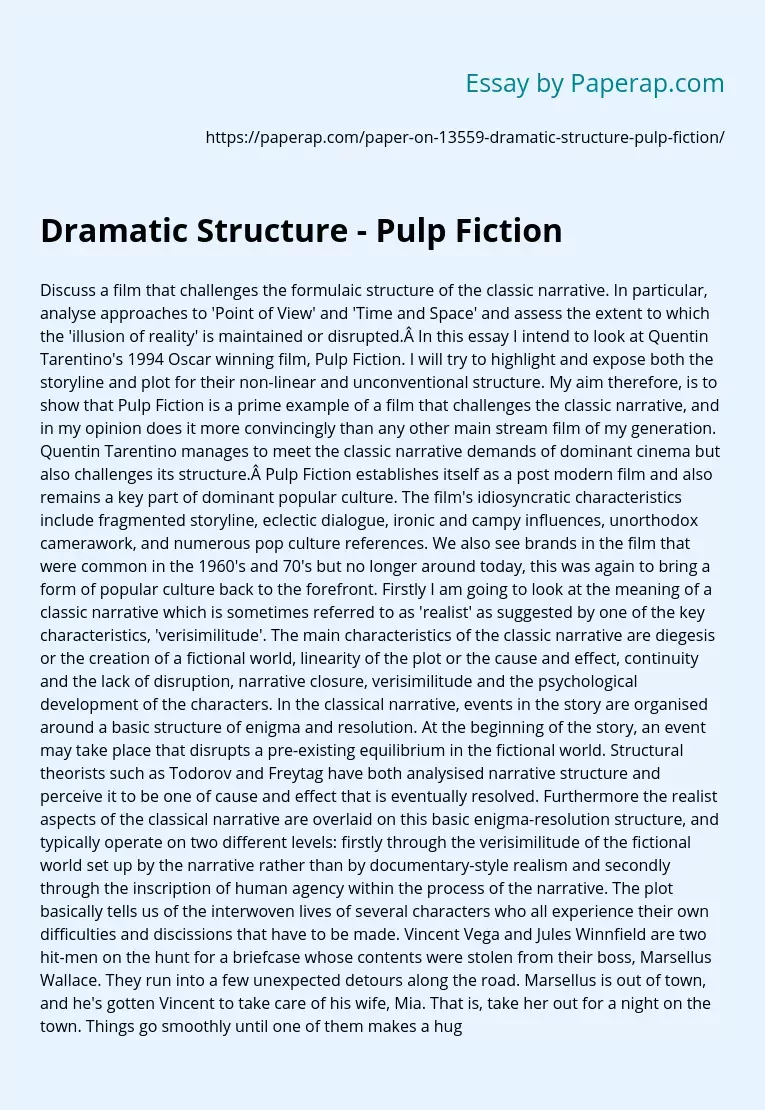Dramatic Structure - Pulp Fiction
Discuss a film that challenges the formulaic structure of the classic narrative. In particular, analyse approaches to ‘Point of View’ and ‘Time and Space’ and assess the extent to which the ‘illusion of reality’ is maintained or disrupted. In this essay I intend to look at Quentin Tarentino’s 1994 Oscar winning film, Pulp Fiction. I will try to highlight and expose both the storyline and plot for their non-linear and unconventional structure.
My aim therefore, is to show that Pulp Fiction is a prime example of a film that challenges the classic narrative, and in my opinion does it more convincingly than any other main stream film of my generation.
Quentin Tarentino manages to meet the classic narrative demands of dominant cinema but also challenges its structure. Pulp Fiction establishes itself as a post modern film and also remains a key part of dominant popular culture. The film’s idiosyncratic characteristics include fragmented storyline, eclectic dialogue, ironic and campy influences, unorthodox camerawork, and numerous pop culture references.
We also see brands in the film that were common in the 1960’s and 70’s but no longer around today, this was again to bring a form of popular culture back to the forefront.
Firstly I am going to look at the meaning of a classic narrative which is sometimes referred to as ‘realist’ as suggested by one of the key characteristics, ‘verisimilitude’. The main characteristics of the classic narrative are diegesis or the creation of a fictional world, linearity of the plot or the cause and effect, continuity and the lack of disruption, narrative closure, verisimilitude and the psychological development of the characters.
In the classical narrative, events in the story are organised around a basic structure of enigma and resolution. At the beginning of the story, an event may take place that disrupts a pre-existing equilibrium in the fictional world. Structural theorists such as Todorov and Freytag have both analysised narrative structure and perceive it to be one of cause and effect that is eventually resolved. Furthermore the realist aspects of the classical narrative are overlaid on this basic enigma-resolution structure, and typically operate on two different levels: firstly through the verisimilitude of the fictional world set up by the narrative rather than by documentary-style realism and secondly through the inscription of human agency within the process of the narrative.
The plot basically tells us of the interwoven lives of several characters who all experience their own difficulties and discissions that have to be made. Vincent Vega and Jules Winnfield are two hit-men on the hunt for a briefcase whose contents were stolen from their boss, Marsellus Wallace. They run into a few unexpected detours along the road. Marsellus is out of town, and he’s gotten Vincent to take care of his wife, Mia.
That is, take her out for a night on the town. Things go smoothly until one of them makes a huge error. Butch Coolidge is a boxer who’s been approached by Marsellus and been told to throw his latest fight. When Butch ends up killing the other boxer, he must escape Marsellus. Pumpkin and Honey Bunny are two thieves who have decided to rob the restaurant they’re currently eating at. But the restaurant doesn’t turn out to be as easy as the other places they’ve robbed.
All these stories were written and told in a non-chronological order, we find a fragmented storyline, unorthodox camera work and numerous pop culture references, all challenging the classic narrative we come to expect from a main stream film. The film’s title and advert/cover refers to the pulp magazines popular during the mid-20th century, renowned for their strong graphic nature.
The film as a whole can be broken up into six major parts, we do see within these parts a beginning, middle and an end for the multiple stories and characters, it is not clear however, where these elements fit in. Also we find that there is no unified but a multiple narrative, as each character shares with us there own idea of resolution and what they are trying to achieve during the film. The itself is well known for its cross cutting between stories, characters, time and space, all acting as devices to challenge the Todorov analysis of a classic structure.
The opening shot is the dictionary definition of the word ‘pulp’ followed by the reference to the magazines and their strong graphic nature. This is there to tell us immediately what to expect from the rest of the film. The first part of the film, ‘The Diner part 1’, introduces us to a pair of petty crooks drinking coffee and talking about their aspirations and achievements. At this point in the film we don’t know there names just that their occupation is holding up shops. Straight away we see intertexuality of a crime genre just from the dialogue used.
Dramatic Structure - Pulp Fiction. (2018, Jan 29). Retrieved from https://paperap.com/paper-on-13559-dramatic-structure-pulp-fiction/

